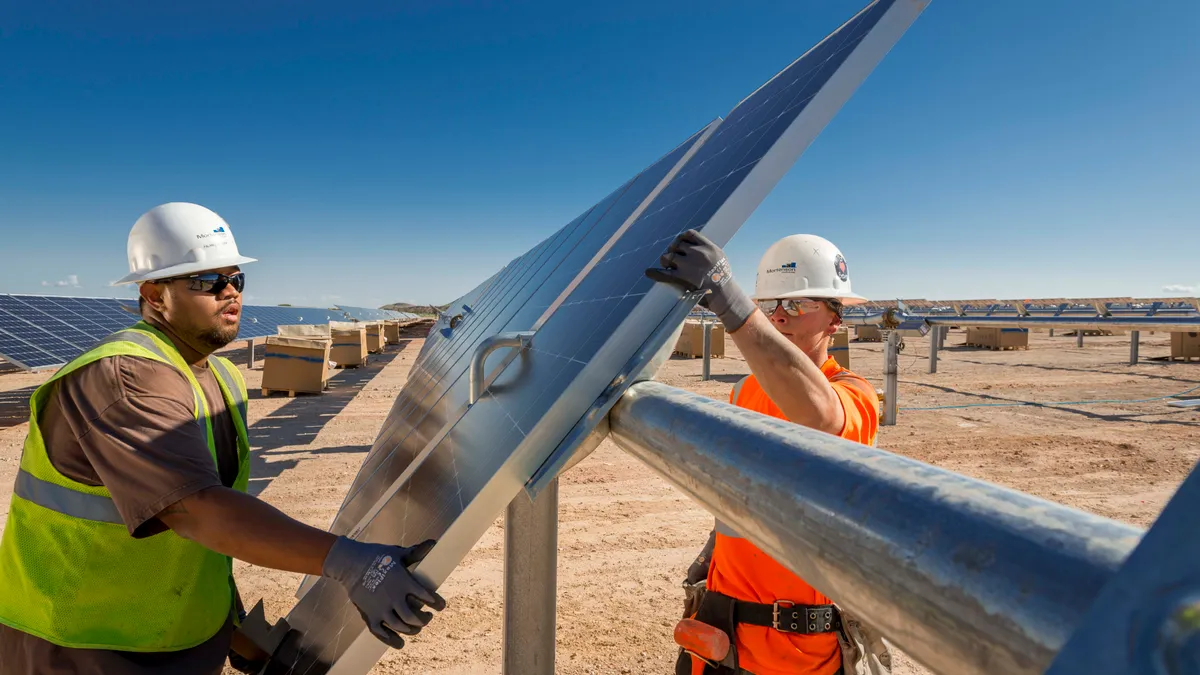Dive Brief:
- One day before the final hearing at the U.S. Office of the Trade Representative (USTR), the Solar Energy Industries Association unveiled a new strategy aimed at appealing to President Donald Trump's protectionist tendencies in order to forestall any potential tariffs in a high-profile trade case.
- Titled "America First Plan for Solar Energy," SEIA lays out six steps for Trump to take to "maintain the solar industry's booming growth." The first step? Reject all tariff proposals.
- SEIA's move underscores the intense lobbying from both sides of the solar trade case. An E&E News report revealed that Suniva, one of the petitioners in the Section 201 trade case, met with the USTR before filing its petition in April.
Dive Insight:
SEIA has not held back in its push to curtail any attempts by the Trump administration to impose tariffs or other remedies on imported crystalline silicon photovoltaic (CSPV) modules and panels. Earlier this year, two domestic manufacturers petitioned the U.S. International Trade Commission for relief, invoking the rarely-used Section 201 global safeguard measure under the Trade Act of 1974.
The ITC found cause for serious injury in a unanimous decision in September, and later recommended three separate remedies to President Trump, with whom the final decision rests.
But SEIA hopes to persuade Trump to take no action by proposing a plan in a press conference today using language frequently employed by the administration. These include "energy dominance," an emphasis on military veterans and "Make America First."
If "the government lets the market work," new installations would triple by 2022, according to the latest joint report from GTM Research and SEIA. The solar trade group noted the domestic solar industry employed 38,000 in the manufacturing space. But it appears most of those manufacturing jobs concentrate on solar equipment such as inverters and mounting devices for panels, not those in the CSPV realm, which is under the Section 201 investigation.
If tariffs are imposed as proposed by Suniva and fellow petitioner SolarWorld, who joined later in May, it could cost as much as 88,000 new jobs next year, SEIA said.
SolarWorld and Suniva are seeking a declining tariff that begins at $0.25/watt for solar cells. For solar modules, they want tariffs that start at $0.32/watt and fall to $0.29/watt in four years. Suniva is also seeking a declining floor price of $0.74/watt for solar modules that falls to $0.64/watt over a four-year span. SolarWorld requested quotas of 0.22 GW on imported cells and 5.7 GW on imported modules in 2018. Both companies want the remedies in place for four years — the full length of time permitted under Section 201, although they can be renewed for another four years.
SEIA has not issued revised numbers in light of the softer remedies recommended by the ITC at the end of October. SEIA President Abby Hopper acknowledged at the press conference that the impact to solar jobs —mostly contained in the downstream supply chain — would be softer but "still in the tens of thousands."
Both sides appear very confident they hold Trump's ear. Even in light of E&E News' revelation about Suniva's meeting with USTR in March, Hopper remains confident they will win the outcome.
"The E&E article did not change our position, it did not affect our confidence," Hopper said. "I think we will remain adamant in our argument that the tariffs that have been requested and even the tariffs recommended by the Commissioners would be devastatingly harmful to the solar industry."
But the industry is beginning to feel the pinch from the uncertainty. A $100 million, 100 MW solar project near Fort Stockton, Texas is on hold. A new GTM Research report also noted a spike in demand due to concerns over potential tariffs that caused module prices to increase from $0.33/watt in Q1 2017 to $0.47/watt for fixed-tilt, utility scale solar.
Opponents and proponents will be able to air their concerns at a final public hearing at the USTR on Wednesday.














